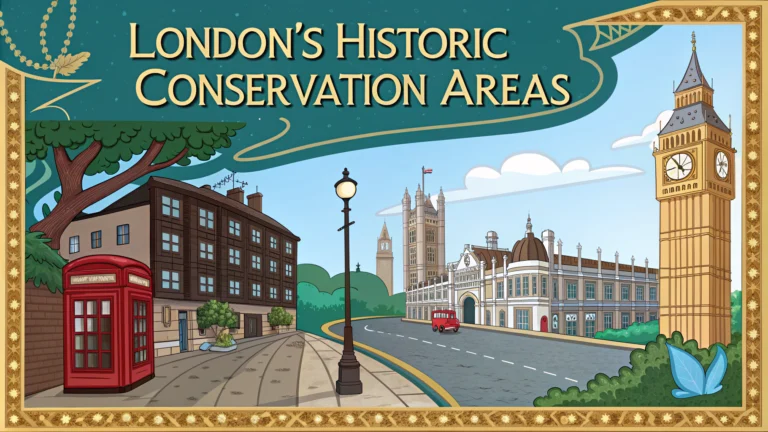London’s historic conservation areas protect and preserve the city’s architectural heritage and unique character for future generations.
These designated zones, covering about 19% of London’s land area, include over 1,000 distinct neighborhoods with special architectural or historic interest.
Understanding conservation area regulations is essential for property owners and developers planning any modifications or improvements within these protected districts.
What Are Conservation Areas?
- Areas of special architectural or historic interest
- Protected by law under the Planning (Listed Buildings and Conservation Areas) Act 1990
- Managed by local borough councils
- Include both residential and commercial properties
Key Restrictions in Conservation Areas
Property owners must obtain permission for many external changes that might normally be permitted elsewhere.
- Window replacements or alterations
- Changes to roofing materials
- Installation of satellite dishes
- Tree removal or major pruning
- Demolition of structures
- Extensions and alterations
Notable Conservation Areas in London
| Area | Borough | Notable Features |
|---|---|---|
| Hampstead | Camden | Georgian architecture, historic village center |
| Greenwich | Greenwich | Maritime history, UNESCO World Heritage site |
| Bloomsbury | Camden | Georgian squares, literary history |
Planning Applications in Conservation Areas
Submit applications through your local borough council’s planning department.
- Pre-application consultation recommended
- Detailed drawings required
- Heritage statement necessary
- Processing time: 8-13 weeks
Tips for Property Owners
- Research your area’s specific guidelines before planning work
- Photograph existing conditions before starting any projects
- Consult conservation officers early in the planning process
- Use approved contractors with conservation area experience
- Keep original features where possible
Useful Resources and Contacts
- Historic England: 020 7973 3700 – www.historicengland.org.uk
- London Planning Portal: www.planningportal.co.uk
- SPAB (Society for the Protection of Ancient Buildings): 020 7377 1644
- Georgian Group: 020 7529 8920
- Victorian Society: 020 8994 1019
Living in a Conservation Area
Properties in conservation areas often maintain higher values due to their protected status and character.
- Higher insurance costs possible
- Stricter maintenance requirements
- Additional paperwork for modifications
- Strong community preservation focus
- Better protection against inappropriate development
Making the Most of Heritage Protection
Conservation areas help maintain London’s unique character while allowing for thoughtful development that respects historical context.
Regular maintenance and careful planning ensure these special areas continue to thrive while preserving their distinctive qualities for future generations.
Environmental Considerations
Conservation areas often align with sustainable development principles and environmental protection.
- Energy efficiency improvements must balance with heritage preservation
- Special considerations for solar panel installations
- Traditional materials often have lower carbon footprints
- Green spaces and mature trees protected
- Renovation preferred over demolition
Financial Implications
Costs
- Higher planning application fees
- Specialist materials requirements
- Conservation-approved contractors
- Additional surveys and reports
Benefits
- Potential property value increase
- Heritage grant funding opportunities
- Long-term investment protection
- Reduced local development pressure
Community Engagement
Active participation in conservation area management strengthens local communities.
- Residents’ associations
- Conservation area advisory committees
- Local history groups
- Heritage open days
- Community consultation on major changes
Preserving London’s Heritage for Tomorrow
Conservation areas represent a vital balance between preservation and progress, ensuring London’s historic character endures while meeting modern needs.
- Protecting architectural heritage for future generations
- Maintaining neighborhood character and identity
- Supporting sustainable urban development
- Encouraging responsible property stewardship
- Building stronger communities through shared heritage
FAQs
- What exactly is a Conservation Area in London?
A Conservation Area is a designated zone of special architectural or historic interest that deserves preservation or enhancement. London has over 1,000 such areas protected by law under the Planning (Listed Buildings and Conservation Areas) Act 1990. - Do I need special permission to modify my property in a Conservation Area?
Yes, you need additional planning permission for alterations that might affect the area’s character, including window replacements, exterior painting, roof modifications, and tree removal. - Which are the oldest Conservation Areas in London?
St. Marylebone, Canonbury, and Charlton were among the first areas designated in 1968, with many historic districts in Westminster and Greenwich following shortly after. - How does living in a Conservation Area affect property value?
Properties in Conservation Areas often maintain higher values due to their protected status and historical character, though maintenance costs can be higher due to stricter renovation requirements. - Can I install solar panels on my property in a Conservation Area?
While possible, installation requires careful consideration and often planning permission, especially if the panels would be visible from the street. - Are there restrictions on painting the exterior of my property?
Yes, most Conservation Areas require planning permission for changes to the exterior color scheme to maintain the area’s historical character and visual cohesion. - What happens if I make unauthorized changes to my property?
Unauthorized modifications can result in enforcement action, requiring restoration to the original state, and possible fines or legal proceedings. - Can trees be removed in Conservation Areas?
Trees with a trunk diameter exceeding 75mm at 1.5m height require six weeks’ written notice to the local authority before any work can commence, including removal or pruning. - How do I find out if a property is in a Conservation Area?
You can check your local council’s website, review the London Heritage Map, or contact your borough’s planning department directly. - Are there grants available for maintaining properties in Conservation Areas?
Some local authorities and heritage organizations offer grants for restoration and maintenance work, though availability varies by borough and funding period.








